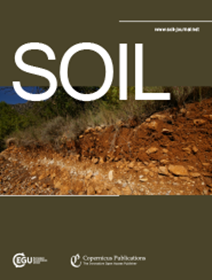Effect of colloidal particle size on physicochemical properties and aggregation behaviors of two alkaline soils
IF 4.3
2区 农林科学
Q1 SOIL SCIENCE
引用次数: 0
Abstract
Abstract. Colloidal particles are the most active soil components, and they vary in elemental composition and environmental behaviors with the particle size due to the heterogeneous nature of natural soils. The purposes of the present study are to clarify how particle size affects the physicochemical properties and aggregation kinetics of soil colloids and to further reveal the underlying mechanisms. Soil colloidal fractions, from two alkaline soils – Anthrosol and Calcisol – were subdivided into three ranges: d<2 µm, d<1 µm and d<100 nm. The organic and inorganic carbon contents, clay mineralogy and surface electrochemical properties, including surface functional groups and zeta potentials, were characterized. Through a time-resolved light scattering technique, the aggregation kinetics of soil colloidal fractions were investigated, and their critical coagulation concentrations (CCCs) were determined. With decreasing colloidal particle diameter, the total carbon content, organic carbon, organic functional groups' content and illite content all increased. The zeta potential became less negative, and the charge variability decreased with decreasing particle diameter. The CCC values of Anthrosol and Calcisol colloids followed the descending order of d<100 nm, d<1 µm and d<2 µm. Compared with the course factions (d<1 and d<2 µm), soil nanoparticles were more abundant in organic carbon and more stable clay minerals (d<100 nm); thus they exhibited strongest colloidal suspension stability. The differences in organic matter contents and clay mineralogy are the fundamental reasons for the differences in colloidal suspension stability behind the size effects of Anthrosol and Calcisol colloids. The present study revealed the size effects of two alkaline soil colloids on carbon content, clay minerals, surface properties and suspension stability, emphasizing that soil nanoparticles are prone to be more stably dispersed instead of being aggregated. These findings can provide references for in-depth understanding of the environmental behaviors of the heterogeneous soil organic–mineral complexes.胶体粒径对两种碱性土壤理化性质及团聚行为的影响
摘要。胶体颗粒是最活跃的土壤成分,由于天然土壤的非均质性,它们的元素组成和环境行为随粒径的不同而变化。本研究的目的是阐明粒径如何影响土壤胶体的物理化学性质和聚集动力学,并进一步揭示潜在的机制。来自两种碱性土壤(Anthrosol和Calcisol)的土壤胶体组分被细分为三个范围:d<2µm, d<1µm和d<100 nm。表征了有机碳和无机碳含量、粘土矿物和表面电化学性质,包括表面官能团和zeta电位。采用时间分辨光散射技术,研究了土壤胶体组分的聚集动力学,并测定了其临界凝聚浓度。随着胶体粒径的减小,总碳含量、有机碳含量、有机官能团含量和伊利石含量均增加。zeta电位负性减弱,电荷变异性随粒径的减小而减小。Anthrosol和Calcisol胶体的CCC值依次为d<100 nm、d<1µm和d<2µm。与d<1µm和d<2µm层段相比,土壤纳米颗粒有机碳含量更丰富,黏土矿物含量更稳定(d<100 nm);因此,它们表现出最强的胶体悬浮稳定性。有机质含量和粘土矿物的差异是造成人溶胶和钙溶胶粒径效应背后胶体悬浮稳定性差异的根本原因。本研究揭示了两种碱性土壤胶体的粒径对碳含量、黏土矿物、表面性质和悬浮稳定性的影响,强调土壤纳米颗粒倾向于更稳定地分散而不是聚集。这些发现可为深入了解非均质土壤有机-矿物复合物的环境行为提供参考。
本文章由计算机程序翻译,如有差异,请以英文原文为准。
求助全文
约1分钟内获得全文
求助全文
来源期刊

Soil
Agricultural and Biological Sciences-Soil Science
CiteScore
10.80
自引率
2.90%
发文量
44
审稿时长
30 weeks
期刊介绍:
SOIL is an international scientific journal dedicated to the publication and discussion of high-quality research in the field of soil system sciences.
SOIL is at the interface between the atmosphere, lithosphere, hydrosphere, and biosphere. SOIL publishes scientific research that contributes to understanding the soil system and its interaction with humans and the entire Earth system. The scope of the journal includes all topics that fall within the study of soil science as a discipline, with an emphasis on studies that integrate soil science with other sciences (hydrology, agronomy, socio-economics, health sciences, atmospheric sciences, etc.).
 求助内容:
求助内容: 应助结果提醒方式:
应助结果提醒方式:


